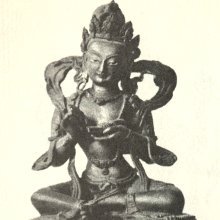Jnanaparamita, Jñānapāramitā, Jnana-paramita: 2 definitions
Introduction:
Jnanaparamita means something in Buddhism, Pali. If you want to know the exact meaning, history, etymology or English translation of this term then check out the descriptions on this page. Add your comment or reference to a book if you want to contribute to this summary article.
Images (photo gallery)
In Buddhism
Tibetan Buddhism (Vajrayana or tantric Buddhism)
Source: archive.org: The Indian Buddhist IconographyJñānapāramitā (ज्ञानपारमिता) refers to one of twelve Pāramitā Goddesses in human form, as commonly depicted in Buddhist Iconography, and mentioned in the 11th-century Niṣpannayogāvalī of Mahāpaṇḍita Abhayākara.—Her Colour is white; her Symbol is the Bodhi tree; she has two arms.
Jñānapāramitā is described in the Niṣpannayogāvalī (dharmadhātuvāgīśvara-maṇḍala) as follows:—
“Jñānapāramitā is white in colour and holds in her left hand the Bodhi tree which is adorned with various kinds of jewels and fruits”.
[The right hand displays the cintamaṇi banner as usual. A statue of this goddess is found in China.
The twelve deities collectively have their spiritual father in Ratnasambhava. [...] According to a statement in the maṇḍala all the deities [viz., Jñānapāramitā] are two-armed, and they hold in the right hand the flag marked with the Cintāmaṇi jewel, and in the left their special symbols. Prajñāpāramitā is an exception since she has two more hands.]

Tibetan Buddhism includes schools such as Nyingma, Kadampa, Kagyu and Gelug. Their primary canon of literature is divided in two broad categories: The Kangyur, which consists of Buddha’s words, and the Tengyur, which includes commentaries from various sources. Esotericism and tantra techniques (vajrayāna) are collected indepently.
General definition (in Buddhism)
Source: Wisdom Library: Dharma-samgrahaJñānapāramitā (ज्ञानपारमिता) or simply jñāna refers to the “perfection of knowledge” and represents the last of the “ten perferctions” (daśapāramitā) as defined in the Dharma-saṃgraha (section 18). The Dharma-samgraha (Dharmasangraha) is an extensive glossary of Buddhist technical terms in Sanskrit (e.g., daśa-pāramitā and jñāna-pāramitā). The work is attributed to Nagarjuna who lived around the 2nd century A.D.
See also (Relevant definitions)
Partial matches: Jnana, Paramita.
Full-text: Paramita, Dashaparamita, Ten Perfections, Samudagama, Jnana, Vihara.
Relevant text
No search results for Jnanaparamita, Jñānapāramitā, Jnana-paramita, Jñāna-pāramitā; (plurals include: Jnanaparamitas, Jñānapāramitās, paramitas, pāramitās) in any book or story.

